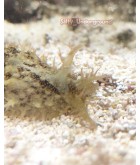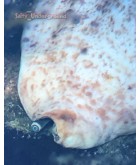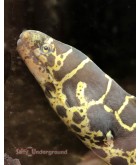Jump to:
- Reef Aquarium LIghting Basics
- Fluorescent Lighting
- Regular Fluorescent Lighting
- Compact Fluorescent
- Very high Output
- High Output
- Other Types of Lighting
- Metal Halide
- LED Lighting
Reef Aquarium Lighting Basics
Metal Halide, Power Compact, T5HO, NO, VHO, and LED
The type of light you can use or need depends on the size aquarium and the coral and other invertebrates that you want in it. Corals and other invertebrates like anemones will need light to sustain them and having the correct spectrum of light and the correct intensity of light needs to be taken into consideration when keeping them.
When you set-up your reef think about the depth of water and the clarity that the animal came from. The deeper the animal in the water the bluer the spectrum of light that reaches it in its nature environment. This is due to the fact that water selectively scatters and absorbs certain wavelengths of visible light. The long wavelengths of the light spectrum like red, yellow, and orange can penetrate from 49 to 164 feet with red being filtered out first and orange last. Short wavelengths of the light spectrum such as violet, blue and green can penetrate further. Blue penetrates the deepest, which is why deep, clear ocean water and some tropical water appear to be blue most of the time. The clarity of the water also matters because clearer waters have fewer particles to affect the transmission of light and this also controls color. Water in shallow coastal areas tends to contain a greater amount of particles that scatter or absorb light wavelengths which is why ocean water close to shore may appear more green or brown in color.
Lighting in the reef aquarium is also your preference. If you know the intensity and spectrum the reef life comes from you can place it higher or lower in the aquarium according to its needs. From my experience the best spectrum of light for a reef aquarium will range between 10,000 Kelvin and 20, 000k. The best light for algae is less than 10,000k which is into the red spectrum. Grow lights for plants are a great example of this because they usually have a spectrum of around 5000k.
Fluorescent Lighting
Regular Fluorescent Light – (NO) Normal Output
Normal output fluorescent is the basic type of lighting that will come with most starter tanks. It is cheap to buy and replace bulb which usually have a Kelvin rating of 3000 to 10000. It is the cheapest lighting to have but is not advisable to use this type of lighting for coral and anemones.
Compact Fluorescent
This is the next step up from the regular fluorescent lights. They typically range from 10 to 100 watts and have Kelvin ratings from 5,000° to 10,000°. They will bring a more intense light and will also put off more heat which may raise the water temperature of the aquarium.
Very High Output (VHO) Fluorescent Light
VHO fluorescent lights usually range from 75-160 watts and have Kelvin ratings from 10,000° to 20,000°. These lights are more expensive and produce more heat than normal output fluorescent lights. This light can be used on a reef aquarium but coral needing brighter light will need to be placed close to the top. This lighting will not penetrate very far in deep aquariums and may not be enough for corals needing bright light to grow well.
High Output (HO) Fluorescent Light- T5HO
T5HO florescent lights typically range from 20-80 watts and have ratings from 6,000 to 11,000 Kelvin. They are again more expensive than regular fluorescents and will need fans to keep them from overheating which will shorten their life. I have had good experiences with this lighting in reef aquarium use up to a medium size aquarium. Corals needing brighter light like xenia grew well and was able to penetrate to the bottom providing light for the low light coral. It can be used to grow SPS coral but still may not be enough light depending on the depth in the aquarium and the type of SPS coral.
Other Types of Lighting
Metal Halide
Metal Halide lamps usually range from 150 -1000 watts and have Kelvin ratings from 3500° to 20,000°. This type of lighting produces a lot of heat and may have to be cooled by a fan depending on the distance from the aquarium and the wattage of the bulb. Caution should be used when using metal halide lighting with acrylic aquariums due to the possibility of heat and UV rays cracking the aquarium. Metal Halide is my overall preferred choice when lighting a reef aquarium and can penetrate to the bottom of most any aquarium. Metal halide lighting will provide enough light for any coral and give you a wide variety of spectrums to choose from.
LED Lighting- Light Emitting Diodes
These lights come with Kelvin ratings from 6500 to 22,000 and have much lower power consumption than metal halides. Other advantages LED lights have are low heat output and longer bulb life. They also have disadvantages like expense and a small light spread. Due to the small light spread more lights need to be used to get the same coverage in an aquarium. This needs to be taken into consideration when placing the coral in the aquarium so gets enough light. My experience with LED lighting was with early models and improvements have been made in the LED systems but with the options out there and their cost I am hesitant to use them anytime soon on a reef aquarium. Supplementing LED lighting with other lighting like T5HO helped with light spread but I was still unable to get the desired growth with the coral on a 400 gallon aquarium.




